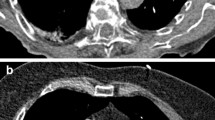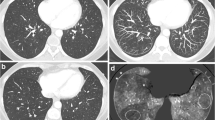Abstract
The purpose of our study was to evaluate detection of central pulmonary embolism (PE) on non-contrast CT. The unenhanced series (PA localizer, 5 mm slice thickness) of 180 CT pulmonary angiograms (CTPA) [90 consecutive CTPA positive for central and proximal interlobar PE taken from 3,161 consecutive CTPA (2.85 % prevalence) mixed with 90 randomly selected negative controls] were independently reviewed by two radiologists (R1 and R2). This was subsequently followed by concluding validation from a third radiologist with access to contrast-enhanced CTPA images and official reports. Six suboptimal studies were excluded. Patient age, gender, hemoglobin value and clot location were recorded. Interobserver agreement, sensitivity, specificity, positive predictive value (PPV) and negative predictive value (NPV) were determined. Sensitivity, specificity, PPV and NPV were 65 % [95 % confidence interval (CI) 54–75 %, 57/88], 49 % (95 % CI 38–60 %, 42/86), 3.6 % (95 % CI 2.8–4.6 %),97.9 % (95 % CI 97.1–98.6 %) for R1, and 55 % (95 % CI 44–65 %, 48/88), 76 % (95 % CI 65–84 %, 65/86), 6.2 % (95 % CI 4.3–9.3 %), 98.3 % (95 % CI 97.8–98.7 %) for R2. Patient age, sex and hemoglobin value were found to have no impact on PE detection. For strictly central PE, sensitivity was 80 % (45/56) (R1) and 70 % (39/56) (R2), while for bilateral PE, sensitivity was 74 % (48/65) (R1) and 66 % (43/65) (R2). For truly positive PE, interobserver agreement was 67 % (59/88) with a moderate Cohen’s kappa of 0.41 (95 % CI 0.24–0.57). In conclusion, non-contrast CT shows high NPV for central PE identification, however it is neither sensitive nor specific enough to accurately detect it.

Similar content being viewed by others
References
Anderson FA Jr, Wheeler HB, Goldberg RJ et al (1991) A population-based perspective of the hospital incidence and case-fatality rates of deep vein thrombosis and pulmonary embolism: the Worcester DVT Study. Arch Intern Med 151(5):933
Konstantinides S (2008) Acute pulmonary embolism. N Engl J Med 359(26):2804–2813
Blachere H, Latrabe V, Montaudon M et al (2000) Pulmonary embolism revealed on helical CT angiography: comparison with ventilation-perfusion radionuclide lung scanning. AJR Am J Roentgenol 174(4):1041–1047
Remy-Jardin M, Remy J, Wattinne L, Giraud F (1992) Central pulmonary thromboembolism: diagnosis with spiral volumetric CT with the single-breath-hold technique–comparison with pulmonary angiography. Radiology 185(2):381–387
Qanadli SD, Hajjam ME, Mesurolle B et al (2000) Pulmonary embolism detection: prospective evaluation of dual-section helical CT versus selective pulmonary arteriography in 157 patients. Radiology 217(2):447–455
Schoepf U, Kessler MA, Rieger CT et al (2001) Multislice CT imaging of pulmonary embolism. Eur Radiol 11(11):2278
Schoepf UJ, Helmberger T, Holzknecht N et al (2000) Segmental and subsegmental pulmonary arteries: evaluation with electron-beam versus spiral CT. Radiology 214(2):433–439
Stein PD, Fowler SE, Goodman LR et al (2006) Multidetector computed tomography for acute pulmonary embolism. N Engl J Med 354(22):2317–2327
Tatco V, Piedad H (2011) The validity of hyperdense lumen sign in non-contrast chest CT scans in the detection of pulmonary thromboembolism. Int J Cardiovasc Imaging 27(3):433–440
Maki DD, Gefter WB, Alavi A (1999) Recent advances in pulmonary imaging. Chest 116(5):1388–1402
Müller NL (2002) Computed tomography and magnetic resonance imaging: past, present and future. Eur Respir J 19(35 suppl):3s–12s
Kanne JP, Gotway MB, Thoongsuwan N, Stern EJ (2003) Six cases of acute central pulmonary embolism revealed on unenhanced multidetector CT of the chest. Am J Roentgenol 180(6):1661–1664
Gotway MB, Webb WR (2000) Acute pulmonary embolism: visualization of high attenuation clot in the pulmonary artery on noncontrast helical chest CT. Emerg Radiol 7(2):117–119
Cobelli R, Zompatori M, De Luca G, Chiari G, Bresciani P, Marcato C (2005) Clinical usefulness of computed tomography study without contrast injection in the evaluation of acute pulmonary embolism. J Comput Assist Tomogr 29(1):6–12
Deak PD, Smal Y, Kalender WA (2010) Multisection CT protocols: sex- and age-specific conversion factors used to determine effective dose from dose-length product. Radiology 257(1):158–166
Landis JR, Koch GG (1977) The measurement of observer agreement for categorical data. Biometrics 33(1):159–174
Kelly J, Hunt BJ (2003) Do anticoagulants improve survival in patients presenting with venous thromboembolism? J Intern Med 254(6):527–539
de Monye W, van Strijen MJ, Huisman MV, Kieft GJ, Pattynama PM (2000) Suspected pulmonary embolism: prevalence and anatomic distribution in 487 consecutive patients. Advances in New Technologies Evaluating the Localisation of Pulmonary Embolism (ANTELOPE) Group. Radiology 215(1):184–188
Donato AA, Khoche S, Santora J, Wagner B (2010) Clinical outcomes in patients with isolated subsegmental pulmonary emboli diagnosed by multidetector CT pulmonary angiography. Thromb Res 126(4):e266–e270
Carrier M, Righini M, Wells PS et al (2010) Subsegmental pulmonary embolism diagnosed by computed tomography: incidence and clinical implications. A systematic review and meta-analysis of the management outcome studies. J Thromb Haemost 8(8):1716–1722
Wittram C, Maher MM, Yoo AJ, Kalra MK, Shepard JA, McLoud TC (2004) CT angiography of pulmonary embolism: diagnostic criteria and causes of misdiagnosis. Radiographics 24(5):1219–1238
Conflict of interest
The scientific guarantor of this publication is Benoit Mesurolle, MD, M Sc. The authors of this manuscript declare no relationships with any companies whose products or services may be related to the subject matter of the article. The authors state that this work has not received any funding. Author Xuanqian Xie has significant statistical expertise and kindly provided statistical advice for this manuscript. Written informed consent was waived by the Institutional Review Board after obtaining their approval.
Author information
Authors and Affiliations
Corresponding author
Rights and permissions
About this article
Cite this article
Sun, S., Semionov, A., Xie, X. et al. Detection of central pulmonary embolism on non-contrast computed tomography: a case control study. Int J Cardiovasc Imaging 30, 639–646 (2014). https://doi.org/10.1007/s10554-013-0356-x
Received:
Accepted:
Published:
Issue Date:
DOI: https://doi.org/10.1007/s10554-013-0356-x




